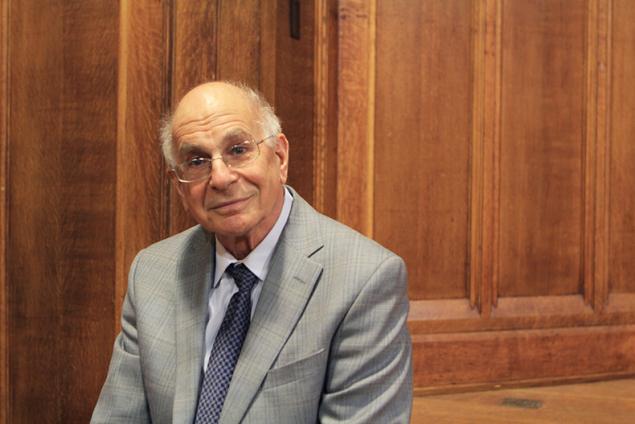467
Daniel Kahneman: to Think and Think — what is the difference
To see how your brain works in automatic mode, look at the picture below.
At the sight of this person in your experience easily connects what we usually call a vision, and intuitive thinking. You can quickly and confidently determined that the woman in the photo has dark hair, and just as easily understood that she was mad. Moreover, you understand something about the future.
You felt that now she says some very unkind words, probably in a loud and harsh voice. This premonition came to mind automatically and effortlessly. You are going to assess her mood or to predict its behavior and reaction on the photo was not felt as the action. It just so happened. This is an example of fast thinking.

Now look at the following problem:
17 × 24
You immediately understand that this is an example on multiplication, and probably realized that it can be solved with pen and paper, and perhaps without them. Also you intuitively estimated range of possible outcomes.
You will quickly realize that the answers 609 12 and 123 are not suitable, but you will need some time to reject the number 568. The exact solution did not occur, and do you feel that you have a choice as to solve the example or not. If you still did not, you need to try and at least partially calculate the result.
Consistently passing these steps, you have got experience slow thinking. First you drew from memory learned in school, cognitive program for multiplication, and then applied it. To calculate had to strain.
You can feel the load on memory due to the large volume of material, since you need to simultaneously keep track of what you've already done and what you intend to do, and not to forget the intermediate result.
The whole process was the work of the mind: a deliberate, time-consuming and orderly, – a sample of slow thinking. In the calculation was involved not only your mind but also the body. You have strained muscles, you have high blood pressure, frequent pulse. An observer would have noticed that while solving you have dilated pupils. They shrank to normal size as soon as you have finished work and found the answer (408) or as soon as you left to deal with an example.

Two systems
For several decades psychologists strongly interested in the two modes of thinking: one that starts portrait of an angry woman, and that starts the task at multiplication. For these modes there is a variety of names. I use the terms originally proposed psychologists Keith Stanovich and Richard West, and will speak about two systems of thinking:
Thinking about yourself, we mean a System 2 – the conscious, rational "I"who has beliefs, which makes choices and decides what to think and what to do. Although System 2 believes itself, and the main character is actually the hero of this book is automatically responsive System 1. I believe she effortlessly generates impressions and feelings that are the main source of beliefs and conscious choices of System 2.
Automatic operation of System 1 generate surprisingly complex patterns of thought, but only the slower System 2 can arrange them in an ordered sequence of steps.
Next will be described the circumstances in which System 2 intercepts control, restricting the free impulses and associations of System 1.
You are invited to consider these two systems as the two subjects, each of which has its own unique abilities, limitations and features.
That's what can make System 1 (examples are ranked in ascending order of complexity):
The ability of the System 1 include our internal skills that we share with other animals. We are born prepared to perceive the world, learn things, pay attention, avoid losses, and fear spiders.
Other actions of the mind become quick and automatic after a long workout. System 1 remember the relationship between ideas (the capital of France?) and learned to recognize and understand the subtleties of situations that arise when communicating.
Some skills, like the ability to find good moves in chess, only acquire experts. The other skills get many. To determine the similarity of the description of the individual with the stereotype of the profession requires a wide linguistic and cultural knowledge available to many. Knowledge is stored in memory, and we get access to it without conscious intention and without effort.
Some of the actions in this list are completely involuntary. You can't keep from understanding simple sentences in their native language or to draw attention to a sudden loud sound; you do not forbid yourself to know that 2 + 2 = 4, or rediscover Paris, if someone mentions the French capital.
A number of actions – for example, chewing – can be controlled, but usually they run on autopilot. The control of attention exercised by the two systems. Orientation to a loud sound usually happens involuntarily, with the help of the System 1, and then immediately and purposefully mobilized, the attention of System 2.
You may keep and will not turn back, hearing a loud insulting remark at a noisy party, but even if your head does not move, at first you will still pay attention to it for a little while. However, from the unwanted object of attention can be diverted, and the best way is to focus on a different goal.
Various functions of System 2 have one feature in common: they all require attention and interrupted when attention switches. For example, using System 2 to do the following:
For example, waiting for a relative in a crowded train station can be configured to look for the gray-haired woman or a bearded man, and, thus, increase the chances of seeing her or him from afar. You can stretch the memory to recall names of the capitals that begin with the letter "N," or the novels of the French writers existentialists. When you rent a car in London Heathrow airport, you will probably remind you that "we drive on the left side".In all these cases you are asked to do something unusual, and you will find that this requires constant efforts.
We often use the phrase "be careful" – and she quite rightly. We have a limited amount of attention that you can allocate to various actions, and if you go beyond the available, nothing happens. A feature of these studies is that they interfere with each other, and it is therefore difficult or even impossible to perform several.
It is impossible to calculate the product 17*24, turning left in heavy traffic; you should not even try. You can do several things at once, but only if they are light and not too required attention. You can probably talk with someone sitting next to if you are driving on an empty highway, and many parents discover – albeit with some degree of embarrassment – that can read your child a story, thinking about something else.
All more or less aware of the limited capacity of attention, and our behavior in society is mindful of these restrictions. For example, if a car driver overtakes a truck on a narrow road, adult passengers reasonably quiet. They know that distracting the driver is not necessary; in addition, they suspect that he is temporarily "deaf" and will not hear their words.

Daniel Kahneman
Focusing on anything, people are, in fact, "going blind", oblivious to the fact that usually attracts attention. This is most clearly demonstrated Sabri Christopher and Daniel Simons in the book "the Invisible gorilla".
They made a short documentary about a basketball match, where teams are in white and black shirts. Viewers are asked to count the number of gear that will make the players in white shirts, ignoring the players in black. It is a difficult task that requires your full attention.
About the middle of the roller in the frame appears a woman in a gorilla suit, which crosses the platform, knocking himself on the breast and leaves. She is in the frame for 9 seconds. Video seen thousands of people, but about half of them didn't notice anything unusual.
Blindness comes from a job count, especially due to the instructions not to pay attention to one of the teams. Viewers who have not received this task, a gorilla.
The secret of the charismatic personalities of theMemory — only version
To see and navigate – automatic functions of System 1, but they are performed only if the relevant external stimuli allotted a certain amount of attention.
According to the authors, the most notable in their study that people are very surprised at the results. The audience did not notice the gorilla at first sure that she wasn't there, they are not able to imagine that missed this event. The experiment with the gorilla illustrates two important facts: we can be blind to the obvious and, moreover, do not notice our own blindness.published
©Daniel Kahneman
Source: www.psychologos.ru/articles/view/soobrazat-i-dumat-bystroe-i-medlennoe-myslenie
At the sight of this person in your experience easily connects what we usually call a vision, and intuitive thinking. You can quickly and confidently determined that the woman in the photo has dark hair, and just as easily understood that she was mad. Moreover, you understand something about the future.
You felt that now she says some very unkind words, probably in a loud and harsh voice. This premonition came to mind automatically and effortlessly. You are going to assess her mood or to predict its behavior and reaction on the photo was not felt as the action. It just so happened. This is an example of fast thinking.

Now look at the following problem:
17 × 24
You immediately understand that this is an example on multiplication, and probably realized that it can be solved with pen and paper, and perhaps without them. Also you intuitively estimated range of possible outcomes.
You will quickly realize that the answers 609 12 and 123 are not suitable, but you will need some time to reject the number 568. The exact solution did not occur, and do you feel that you have a choice as to solve the example or not. If you still did not, you need to try and at least partially calculate the result.
Consistently passing these steps, you have got experience slow thinking. First you drew from memory learned in school, cognitive program for multiplication, and then applied it. To calculate had to strain.
You can feel the load on memory due to the large volume of material, since you need to simultaneously keep track of what you've already done and what you intend to do, and not to forget the intermediate result.
The whole process was the work of the mind: a deliberate, time-consuming and orderly, – a sample of slow thinking. In the calculation was involved not only your mind but also the body. You have strained muscles, you have high blood pressure, frequent pulse. An observer would have noticed that while solving you have dilated pupils. They shrank to normal size as soon as you have finished work and found the answer (408) or as soon as you left to deal with an example.

Two systems
For several decades psychologists strongly interested in the two modes of thinking: one that starts portrait of an angry woman, and that starts the task at multiplication. For these modes there is a variety of names. I use the terms originally proposed psychologists Keith Stanovich and Richard West, and will speak about two systems of thinking:
- System 1 operates automatically and quickly, without requiring or almost requiring effort and not giving the feeling of intentional control.
- System 2 allocates attention required for conscious mental effort, including complex computations. Actions of System 2 are often associated with the subjective feeling of activity, choice and concentration.
Thinking about yourself, we mean a System 2 – the conscious, rational "I"who has beliefs, which makes choices and decides what to think and what to do. Although System 2 believes itself, and the main character is actually the hero of this book is automatically responsive System 1. I believe she effortlessly generates impressions and feelings that are the main source of beliefs and conscious choices of System 2.
Automatic operation of System 1 generate surprisingly complex patterns of thought, but only the slower System 2 can arrange them in an ordered sequence of steps.
Next will be described the circumstances in which System 2 intercepts control, restricting the free impulses and associations of System 1.
You are invited to consider these two systems as the two subjects, each of which has its own unique abilities, limitations and features.
That's what can make System 1 (examples are ranked in ascending order of complexity):
- To determine which of two objects is closer.
- To Orient toward the source of the sudden sound.
- To complete the phrase "Bread with ...".
- To portray a grimace of disgust at the sight of the nasty pictures.
- To determine the hostility in his voice.
- To decide example 2 + 2 =?
- To read the words on large advertising billboards.
- Driving on an empty road.
- To make a strong chess move (if you are a grandmaster).
- To understand a simple sentence.
- To determine that the description "a quiet, tidy person who pay a lot of attention to detail" like the stereotype associated with a certain profession.
The ability of the System 1 include our internal skills that we share with other animals. We are born prepared to perceive the world, learn things, pay attention, avoid losses, and fear spiders.
Other actions of the mind become quick and automatic after a long workout. System 1 remember the relationship between ideas (the capital of France?) and learned to recognize and understand the subtleties of situations that arise when communicating.
Some skills, like the ability to find good moves in chess, only acquire experts. The other skills get many. To determine the similarity of the description of the individual with the stereotype of the profession requires a wide linguistic and cultural knowledge available to many. Knowledge is stored in memory, and we get access to it without conscious intention and without effort.
Some of the actions in this list are completely involuntary. You can't keep from understanding simple sentences in their native language or to draw attention to a sudden loud sound; you do not forbid yourself to know that 2 + 2 = 4, or rediscover Paris, if someone mentions the French capital.
A number of actions – for example, chewing – can be controlled, but usually they run on autopilot. The control of attention exercised by the two systems. Orientation to a loud sound usually happens involuntarily, with the help of the System 1, and then immediately and purposefully mobilized, the attention of System 2.
You may keep and will not turn back, hearing a loud insulting remark at a noisy party, but even if your head does not move, at first you will still pay attention to it for a little while. However, from the unwanted object of attention can be diverted, and the best way is to focus on a different goal.
Various functions of System 2 have one feature in common: they all require attention and interrupted when attention switches. For example, using System 2 to do the following:
- Prepare to signal the start of the race.
- Watch the clowns in the circus.
- To hear in a crowded noisy room the voice of the right person.
- Notice the gray-haired woman.
- To identify a surprising sound, digging into the memory.
- Intentionally to quicken the pace.
- To monitor the appropriateness of behavior in a particular social situation.
- To count the number of vowels in the text.
- Dictate the interlocutor in your telephone number.
- Park where little space (unless you are a professional Valet).
- Compare two washing machines for the price and functions.
- To fill in a tax return.
- To check the consistency of complex logical arguments.
For example, waiting for a relative in a crowded train station can be configured to look for the gray-haired woman or a bearded man, and, thus, increase the chances of seeing her or him from afar. You can stretch the memory to recall names of the capitals that begin with the letter "N," or the novels of the French writers existentialists. When you rent a car in London Heathrow airport, you will probably remind you that "we drive on the left side".In all these cases you are asked to do something unusual, and you will find that this requires constant efforts.
We often use the phrase "be careful" – and she quite rightly. We have a limited amount of attention that you can allocate to various actions, and if you go beyond the available, nothing happens. A feature of these studies is that they interfere with each other, and it is therefore difficult or even impossible to perform several.
It is impossible to calculate the product 17*24, turning left in heavy traffic; you should not even try. You can do several things at once, but only if they are light and not too required attention. You can probably talk with someone sitting next to if you are driving on an empty highway, and many parents discover – albeit with some degree of embarrassment – that can read your child a story, thinking about something else.
All more or less aware of the limited capacity of attention, and our behavior in society is mindful of these restrictions. For example, if a car driver overtakes a truck on a narrow road, adult passengers reasonably quiet. They know that distracting the driver is not necessary; in addition, they suspect that he is temporarily "deaf" and will not hear their words.

Daniel Kahneman
Focusing on anything, people are, in fact, "going blind", oblivious to the fact that usually attracts attention. This is most clearly demonstrated Sabri Christopher and Daniel Simons in the book "the Invisible gorilla".
They made a short documentary about a basketball match, where teams are in white and black shirts. Viewers are asked to count the number of gear that will make the players in white shirts, ignoring the players in black. It is a difficult task that requires your full attention.
About the middle of the roller in the frame appears a woman in a gorilla suit, which crosses the platform, knocking himself on the breast and leaves. She is in the frame for 9 seconds. Video seen thousands of people, but about half of them didn't notice anything unusual.
Blindness comes from a job count, especially due to the instructions not to pay attention to one of the teams. Viewers who have not received this task, a gorilla.
The secret of the charismatic personalities of theMemory — only version
To see and navigate – automatic functions of System 1, but they are performed only if the relevant external stimuli allotted a certain amount of attention.
According to the authors, the most notable in their study that people are very surprised at the results. The audience did not notice the gorilla at first sure that she wasn't there, they are not able to imagine that missed this event. The experiment with the gorilla illustrates two important facts: we can be blind to the obvious and, moreover, do not notice our own blindness.published
©Daniel Kahneman
Source: www.psychologos.ru/articles/view/soobrazat-i-dumat-bystroe-i-medlennoe-myslenie
Brené brown: That's HOW I want to live!
In Amsterdam will be built an eco-building with zero energy consumption























